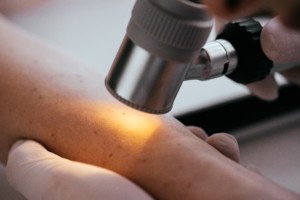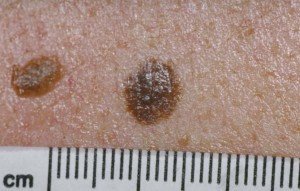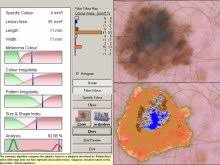At what point should you stop waiting and waiting and finally get a suspicious looking mole checked by a dermatologist?
It’s easy to just say, “You know you should get that suspicious mole checked when you begin feeling uneasy about it.”
But let’s be more specific.
- What do you need to see?
- Does any of your history play into this?
Get that Suspicious Looking Mole Checked When…
• “You tan frequently or have a history of dedicated tanning, then you know you might have melanoma if you find a new mole that appears to be growing,” says Dr. Janet Prystowsky, board certified dermatologist in New York, NY, with 30+ years’ experience.

Melanoma has a poor prognosis once it has spread beyond the deep layer of the skin. Excessive time in the sun is a risk factor.
• “You are over 50, and have a family history of skin cancer, then you know you might have melanoma if you have a bleeding mole,” continues Dr. Prystowsky.
• “Your dermatologist pointed it out at the last exam,” says Estee Williams, MD, a board certified medical, cosmetic and surgical dermatologist and assistant clinical professor in dermatology at Mount Sinai Medical Center.
• “You’re at higher risk of melanoma than the average person – history of melanoma in you or your family; red hair; many blistering sunburns,” adds Dr. Williams.
• Someone else (partner, dentist, hair stylist) says, “Have you always had this mole back here?” and you think, “Where did THAT come from?”
• You keep wondering why one of your moles doesn’t look like the rest.
• You keep wondering if a particular mole has “always looked that way.”
- Melanoma has a 10 year survival rate of 99 percent when caught at its earliest stage.
- At a later stage, the survival rate is very bleak – even for five years.
Trust your gut. When in doubt, have a dermatologist (not a primary care physician) check it out.
Make sure they view it with a dermatoscope — a handheld lens with a light — pictured below.

Dermatoscope. Shutterstock/LightField Studios
Not all benign moles look perfect. The key is to become very familiar with your moles and then surveil them monthly for any suspicious changes.
Dr. Williams’ clinic provides a state-of-the-art technology called serial digital dermoscopy.
All of the patient’s moles are “mapped” photographically, then then fed into a computer database for analysis and flagging for melanoma suspicion.
Every year the same moles are imaged. The computer makes comparisons to previous photos and can detect changes.
This technology provides peace of mind to those who worry about melanoma.

In combination with her focus on early skin cancer detection and removal, Dr. Prystowsky provides a wide range of revitalizing and rejuvenating treatments.











































